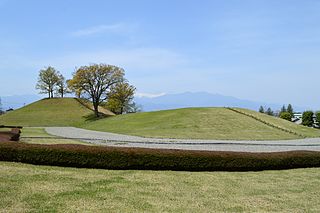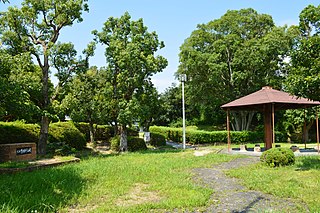
The Dampusan Kofun (断夫山古墳) is a large keyhole-shaped kofun burial mound located within the grounds of the Atsuta Shrine complex in the Hayata neighborhood of Atsuta-ku, Nagoya, Japan. The tumulus was designated a National Historic Site of Japan in 1987. Per legend, the tumulus is the tomb is Miyazuhime, the wife of Prince Yamato Takeru, whose purported grave is located nearby.

The Takarazuka Kofun (宝塚古墳) is a group of Kofun period burial mounds located in the Takarazuka neighborhood of the city of Matsusaka, Mie Prefecture in the Kansai region of Japan. It was designated a National Historic Site of Japan in 1932.

Nishizuka Kofun is a kofun burial mound located in what is now part of the town of Wakasa, Fukui in the Hokuriku region of Japan. The site was designated a National Historic Site of Japan in 1935.

The Jōnozuka Kofun is a kofun burial mound located in the Wakibukuro neighborhood of the town of Wakasa, Fukui in the Hokuriku region of Japan. The site was designated a National Historic Site of Japan in 1935. It is the largest keyhole-shaped tumulus in the Wakasa region and was built from the end of the 4th century to the early 5th century AD.

Shidami Kofun group is a cluster of seven Kofun period burial mounds, located in what is now part of Moriyama-ku, Nagoya, Aichi Prefecture in the Tōkai region of Japan. The Shiratorizuka Kofun was designated a National Historic Site of Japan in 1972 and the remaining six were added to the designation in 2014..

Atagozuka Kofun (愛宕塚古墳) is a Kofun period burial mound located in the town of Mibu, Shimotsuga District, Tochigi Prefecture in the northern Kantō region of Japan. It received protection as a National Historic Site in 1926.

The Ushizuka Kofun (牛塚古墳) is a scallop-shaped Kofun period burial mound located in the town of Mibu, Shimotsuga District, Tochigi Prefecture in the northern Kantō region of Japan. It received protection as a National Historic Site in 1926.

Kurumazuka Kofun (車塚古墳) is a Kofun period burial mound located in the town of Mibu, Shimotsuga District, Tochigi Prefecture in the northern Kantō region of Japan. It received protection as a National Historic Site in 1926.

The Hodota Kofun Cluster (保渡田古墳群) is a group of three Kofun period burial mounds located in what is now the city of Takasaki, Gunma Prefecture in the northern Kantō region of Japan. It was designated a National Historic Site of Japan in 1985.

The Kai Chōshizuka Kofun (甲斐銚子塚古墳) is a kofun burial mound located in the Shimosone neighborhood of the city of Kōfu, Yamanashi in the Chūbu region of Japan. Together with the adjacent Maruyamazuka Kofun (丸山塚古墳) it was designated as a National Historic Site of Japan in 1930. It is one of the largest keyhole-shaped tumuli in eastern Japan and has a total length of 169 meters. The tumuli are located a three minute walk from the "Kenritsukōkohakubutsukan" bus stop on the Yamanashi Kōtsu Kankō Bus from Kōfu Station.

The Funazukayama Kofun (舟塚山古墳) is a large Kofun period burial mound located in the Kitanemoto neighborhood of the city of Ishioka, Ibaraki in the northern Kantō region of Japan. The tumulus was designated a National Historic Site in 1921. It is the largest in Ibaraki Prefecture and the second largest in the Kantō region after the Ōta Tenjinyama Kofun in Ōta, Gunma.

The Shibayama Kofun cluster (芝山古墳群) is a group of Kofun period burial mounds located in what is now the Nakadai neighborhood of the town of Yokoshibahikari, Chiba Prefecture in the Kantō region of Japan. The site was designated a National Historic Site of Japan in 1958. Despite its name, it is not located in the town of Shibayama, but in neighboring Yokoshibahikari, and it is also called the Nakadai kofun cluster (中台古墳群).

Imashirozuka Kofun (今城塚古墳) is a Kofun period keyhole-shaped burial mound, located in the Gungeshinmachi neighborhood of the city of Takatsuki, Osaka in the Kinai region of Japan. The tumulus was designated a National Historic Site of Japan in 1958, with the area under protection expanded in 2006. It is the largest kofun in the Yodo River basin and one of the largest constructed in the first half of the 6th century. Although it has not been sanctioned by the Imperial Household Agency, there is a strong theory that it is the true tomb of the 26th Emperor Keitai.

The Makino Kurumazuka Kofun (牧野車塚古墳) is a Kofun period keyhole-shaped burial mound, located in the Ogura Higashimachi neighborhood of the city of Hirakata, Osaka in the Kansai region of Japan. The tumulus was designated a National Historic Site of Japan in 1922 with the area under protection expanded in 1980.

The Kinyakurumazuka Kofun (禁野車塚古墳) is a Kofun period keyhole-shaped burial mound, located in the Miyanosaka neighborhood of the city of Hirakata, Osaka in the Kansai region of Japan. The tumulus was designated a National Historic Site of Japan in 1972 with the area under protection expanded in 2007.

The Hisagozuka Kofun (瓢塚古墳), also known as the Yoro-Hisagozuka Kofun (丁瓢塚古墳), is a kofun burial mound located in the Katsuhara neighborhood of the city of Himeji, Hyōgo Prefecture, in the Kansai region of Japan. The tumulus was designated a National Historic Site in 1978.

The Goshikizuka Kofun (五色塚古墳) is a kofun burial mound located in the Goshikiyama neighborhood of Tarumi-ku, Kobe, Hyōgo Prefecture, in the Kansai region of Japan. The tumulus is the largest in Hyōgo Prefecture, and is estimated to have been built around the end of the 4th century and the beginning of the 5th century. It is known as the first kofun to be restored to what archaeologists believe to be its original appearance. It is also known as the Sentsubo Kofun (千壺古墳). Together with the smaller neighboring Kotsubo Kofun (小壺古墳) it was designated a National Historic Site in 1921, with the area under protection extended in 1974, 1979 and 2006.

Ryōgūzan Kofun (両宮山古墳) is a Kofun period burial mound, located in the city of Awaiwa, Okayama Prefecture, in the San'in region of Japan. The tumulus was designated a National Historic Site of Japan in 1924 with the area under protection expanded in 1978 and again in 2006. It is largest keyhole-shaped burial mound in the Bizen region and the third largest in Okayama Prefecture, and the 39th largest in Japan.

Kōmorizuka Kofun (こうもり塚古墳) is a Kofun period burial mound, located in the Kanbayashi neighborhood of the city of Sōja, Okayama Prefecture, in the San'yō region of Japan. The tumulus was designated a National Historic Site of Japan in 1968. It was formerly known as the Kurohimezuka Kofun (黒姫塚古墳).

Ōsumi Kurumazuka Kofun (大住車塚古墳) is a Kofun period keyhole-shaped burial mound, located in the Ōsumi-Hachiōji neighborhood of the city of Kyōtanabe, Kyoto in the Kansai region of Japan. The tumulus was designated a National Historic Site of Japan in 1974.


























